
30 Sept-3 Oct 2015. We arrive in Amman late afternoon on September 30th. It is an easy entry. We are met at the airport prior to passport control to ensure our free visas that come with being part of a tour. An agent of the tour company takes us quickly through passport control and baggage claim and out to the taxi that takes us to our hotel. On the drive from the airport I’m struck by the uniformity of the buildings. Unlike most cities where there is a variety of styles and colours, in Amman they are all the same. I learn later that there is a municipal law requiring all buildings to be faced with the same creamy coloured local stone.
For almost two full days we hardly leave the hotel room. After being on the move in Turkey for five weeks we need a day off. Our hotel is not in a busy part of Amman. It seems like it’s in the middle of nowhere really. For dinner the first night we eat at the nearby Pizza Hut because of convenience, and because we can’t really find anything else, and because we don’t have the energy to look too far afield. It’s not very good. The hotel provides breakfast and we take enough from the buffet to make lunch in our room. Finally mid afternoon on the third day we get a taxi to Rainbow Street.
Named for the trendy Rainbow Theatre, Rainbow Street is a nucleus of cafés and restaurants, but not for us. It is Friday, the Muslim day of prayer, so almost everything is closed and the street is quiet.

The hotel has no English-language maps of the city. Amman is not that user friendly for tourists. On Rainbow Street we find a tourist police booth and ask for a map. The only map he has in English is a large glossy poster-style map that clearly had once been stuck up on the wall. The streets are hidden under small illustrations of landmarks, and there is not nearly enough detail of the main downtown area. It is however better than nothing. With the dubious help of the map, and through asking, and winding our way down unmarked staircases, we arrive at the Al Husseini Mosque right in the centre of downtown. It is busy. Amman is happening here even though many of the smaller side streets of the souq across from the mosque are closed. We hang out in the square in front of the mosque as the men come out from prayer. Many of them are immediately attracted to a large pile of cell phone covers for sale.
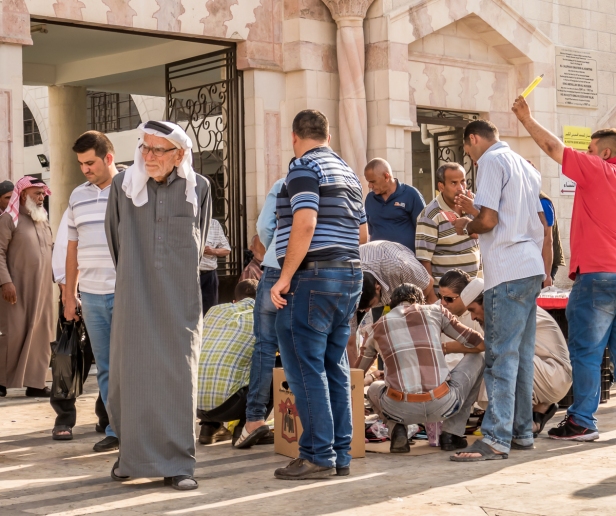
I go inside the mosque. I am gestured upstairs to the women’s prayer room above. It overlooks the main area of the mosque where the men are. There are a couple of women in the room. They are welcoming and friendly. I feel a warmth with them. And they are fine with me taking photos through the windows that look down on the courtyard and interior below.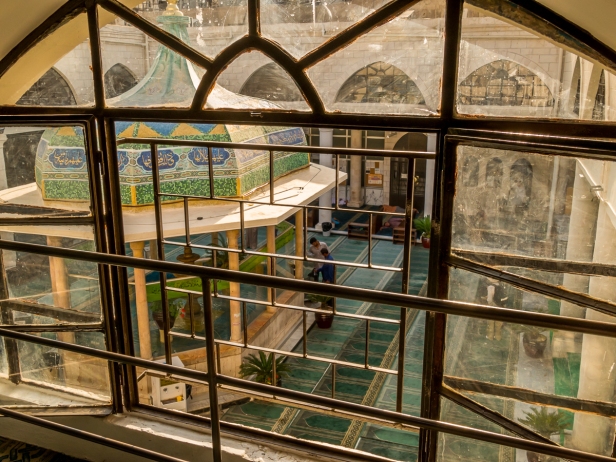
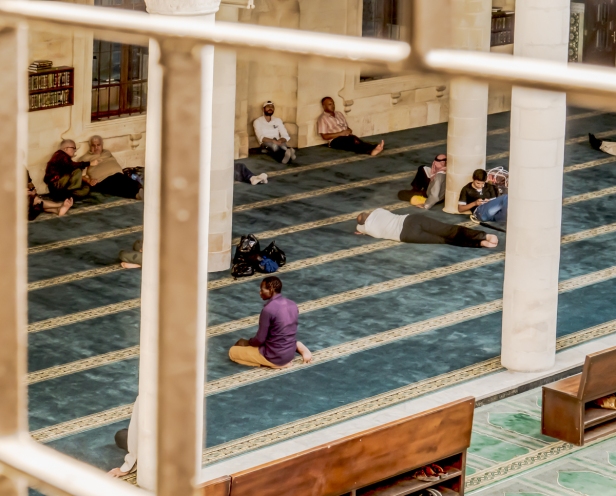
I don’t mind the separation, though I don’t understand it. What saddens me is that in every mosque I enter in Turkey and Jordan I see that the space for women is ‘second-class’. No space for women that I see has the same glorious beauty, grandeur, or importance as the space for the men. Why is that? Meanwhile downstairs, Don has a conversation with an English speaking man who would like to convert him to Islam.
It’s busy in the square in front of the mosque. Hawkers are shouting their wares, crowds coming and going, a man sells juice from an elaborate metal urn strapped to his back, a jewellery stand is ready for business.
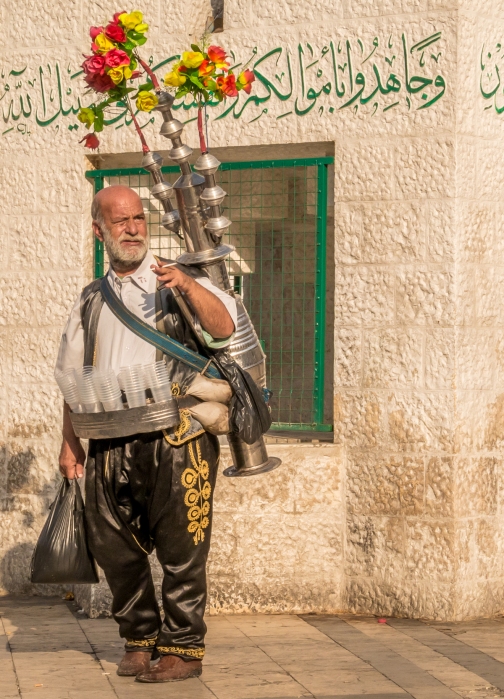
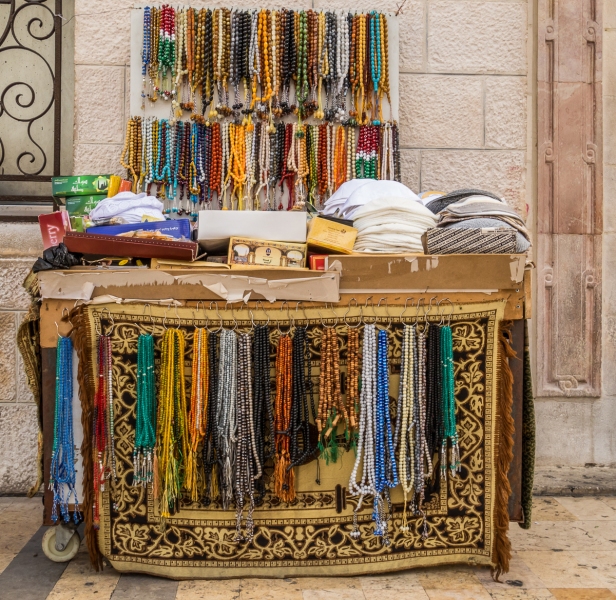
We explore the souq across the hectic main road from the mosque. We are in the bustling hustling centre of the old city. Here is the hubbub of Jordanian life. At the sidewalk stands and down numerous alleys there is everything for sale that you could imagine – everything from belly dance outfits to jewellery, clothing, hijabs, fruit and vegetables, antiques, a pipe, and a plastic hippopotamus.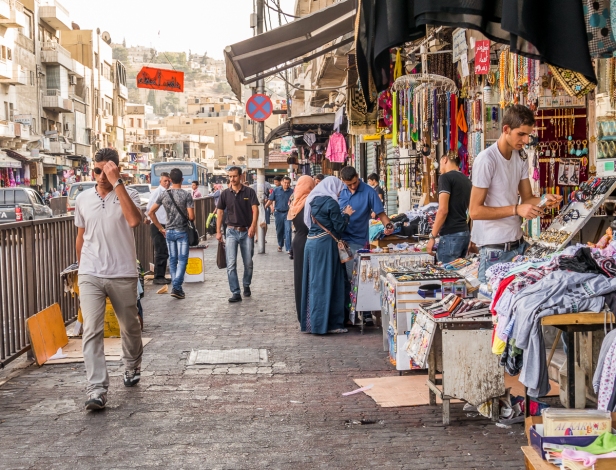
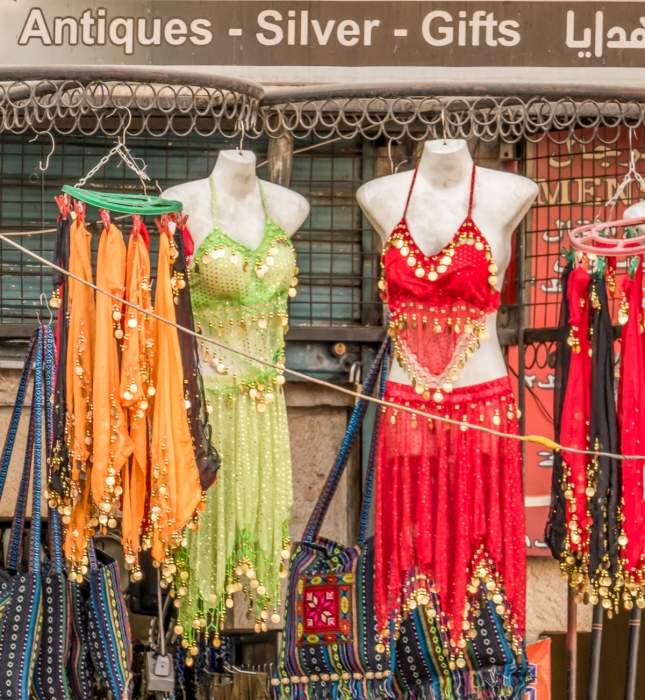
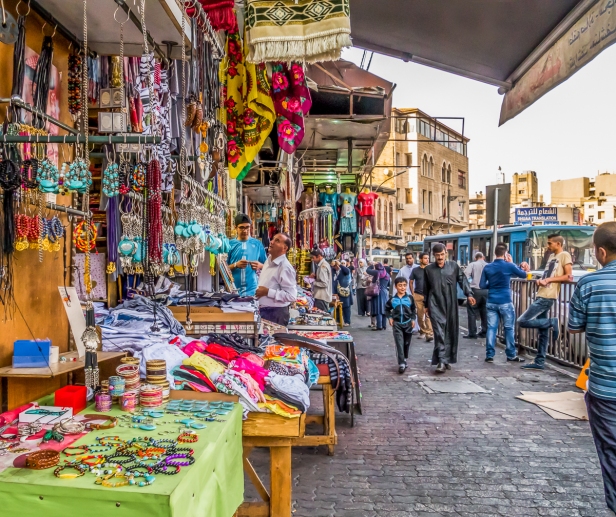

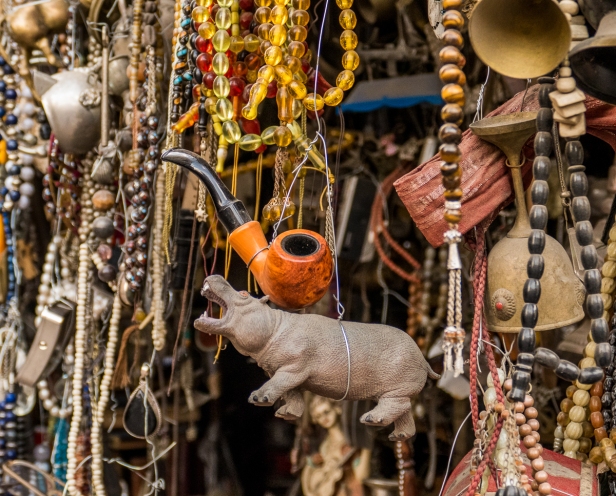
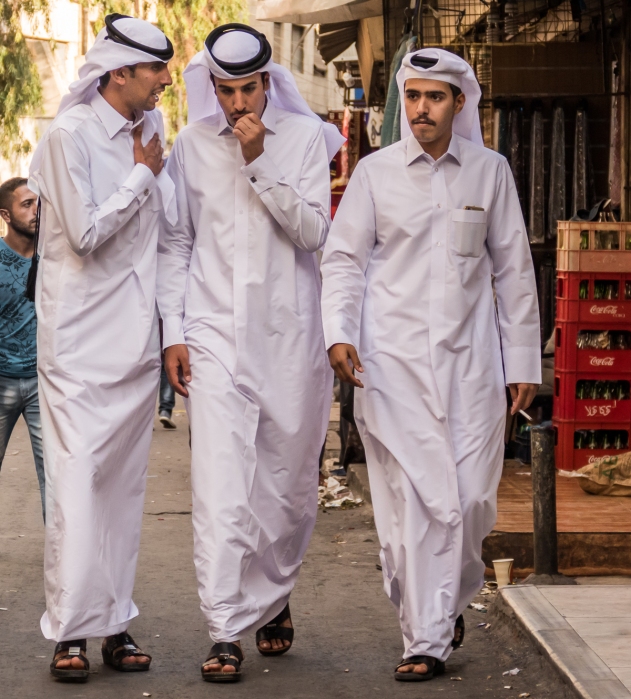


We have the most fun in a small alley that I immediately dub ‘Sewing Street’, though perhaps a better name would be ‘Tailor Street’. The alley is filled on either side with rows and rows of jackets and shirts hanging above and many men at their sewing machines making new clothes.
We have fun and funny interactions with the tailors, taking photos, establishing that we are Canadian, and that one of the men we ‘talked’ with was from Cairo. There is much laughter, smiling, and communication despite their lack of English and our lack of Arabic. It reminds me very much of our visit to the wholesale spice market in Delhi.
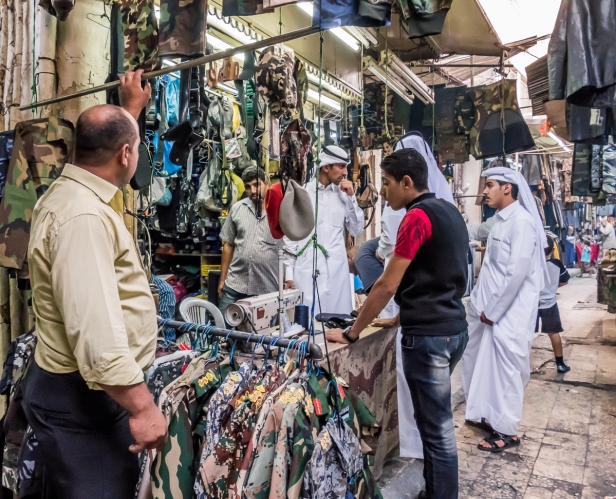

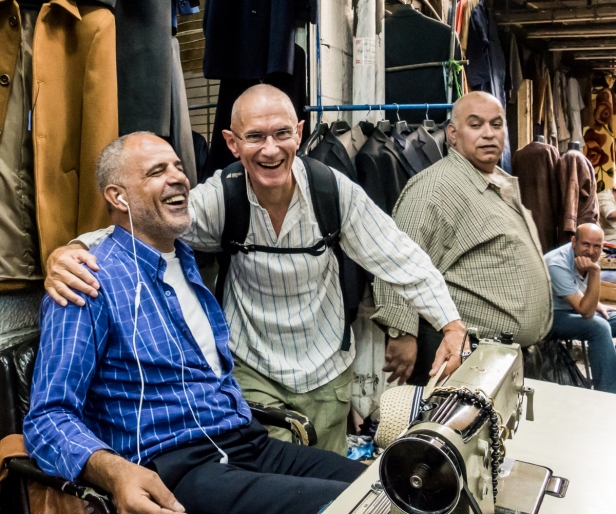
The country that is now the Hashemite Kingdom of Jordan has been inhabited since the Paleolithic period. By the end of the Bronze Age three kingdoms emerged: Ammon (from which Amman gets its name), Moab and Edom. These lands later became part of the Nabatean Kingdom, the Roman Empire, and then the Ottoman Empire. In the aftermath of WW I, as part of the partitioning of the Ottoman Empire, the British, with the help of the Hashemites, forced the Ottomans out and established, in 1921, the Emirate of Transjordan as a British protectorate. Jordan became an independent sovereign state in 1946. In 1948 the name was changed to the Hashemite Kingdom of Jordan, and the monarchy continues to rule to this day.
Jordan is a small, almost landlocked, remarkably hospitable country. Surrounded by conflict it has welcomed millions of refugees: Palestinians, Syrians, Iraqis. The country is one of two Arab states to have signed a peace treaty with Israel. Although there is a strong middle-class in the city, Amman has surprised us. We expected a wealthy country, and maybe there are wealthy people here but not in the part of city we’ve seen. It feels more like a third-world country – the sidewalks are uneven and crumbling, or nonexistent, there is garbage everywhere, and on the climb up to the Citadel we see that people are living in very simple dwellings built into the side of the hill. The western side of town is wealthier, but Jordan does not have the oil wealth that one generally associates with this part of the world.
From the souq we make our way by accident to the Nymphaeum, one of the many Roman antiquities to be found in Amman. There’s a tiny illustration of the Nymphaeum on the map so we once again have some idea of where we are, but the illustration covers some of the streets. By feel, and by asking, we continue optimistically in the direction of the Citadel, hoping to reach it for sunset. By this point we are ready for a break and a cup of coffee but don’t see a suitable place. We round a corner in what we hope is the right direction. Suddenly a man speaks to us in English, encouraging us to come to his place for coffee, and yes he will show us the way to the Citadel when we are done. He ushers us into the funky lounge and bar of a hotel, a place we would not have thought to enter on our own even if we’d noticed it. It is lovely: tea for Don, coffee for me, and wonderful cake. When we are finished we are pointed in the direction of the Citadel with a small map printed from a drawing. It feels as if the Universe had sent us an angel to guide us to both the break we need and the way to the Citadel. Our serendipity mojo seems to be working again.
The map is not the territory, but it is enough for us to find our way.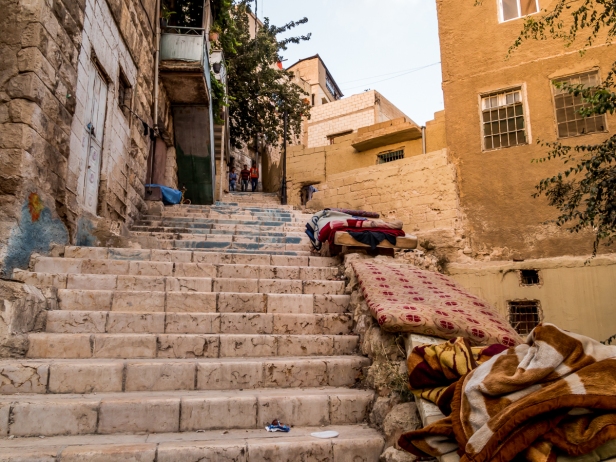
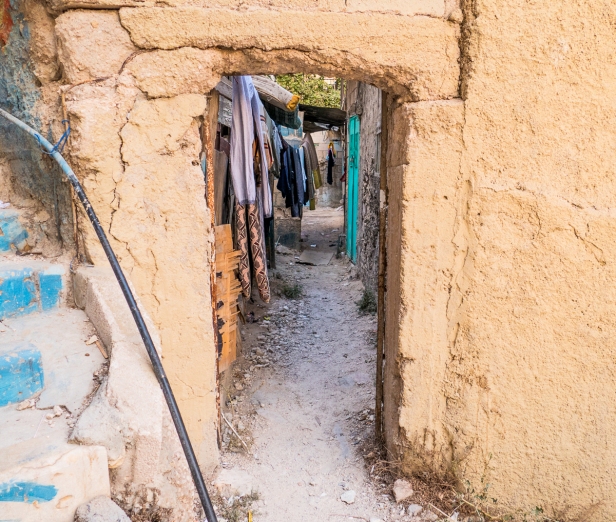
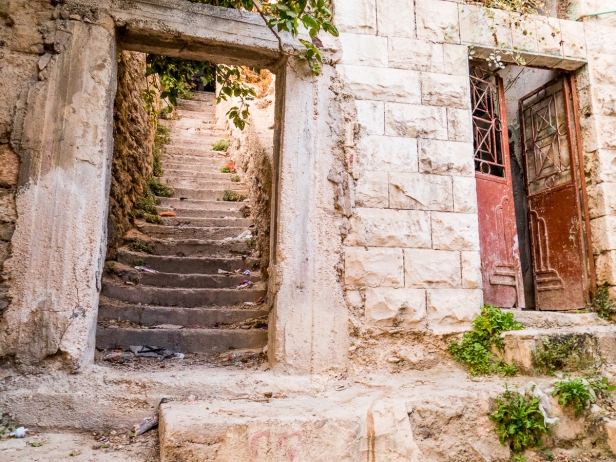

When we arrive the Citadel is closing so we can’t go inside, but the sunset makes it worth the climb.
We are aware of a couple asking one of the guards how they are to get back to town. We tell them that we know the way. So we walk back down the hill with Ross from Australia and Tanya from Russia.
We had been told at the hotel where we’d had our break that they had a rooftop restaurant and that the chef was really good, and that he used to be a chef at the palace, so we decide to go there for dinner and invite Ross and Tanya to join us.
Up we go to the rooftop and enter into a completely surreal experience: it is shabby and dark, there are several rabbits and chickens running around, and there are three hawks and an owl in a cage in one corner.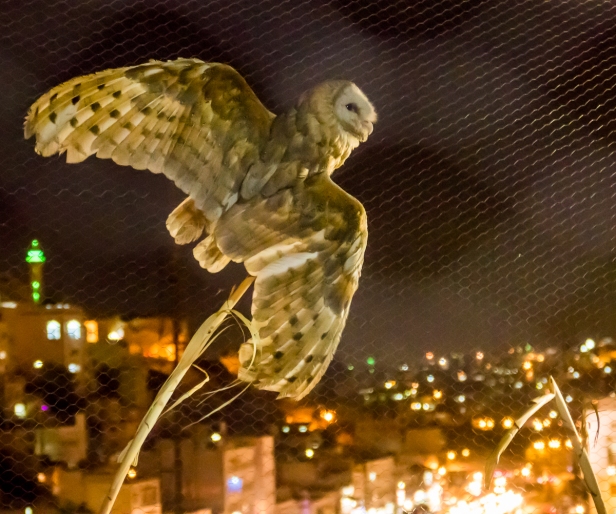
We sit at a table by the wall of the terrace looking out at a fabulous view of Amman and the Roman Theatre.
We order from the menu. Sorry, there are no stuffed vine leaves available; there are also no vegetables available for chicken stir-fry. So we all reorder. Don and I share Greek salad, hummus, and a half chicken and chips. The other two share a whole chicken and chips, a bottle of wine and some falafel. We wait and wait and wait. Eventually it all comes. The hummus is as it should be. The Greek salad is just okay. There are only five falafel balls when there should be six. The chips are cold and soggy and the chicken is overdone. Seriously overdone. But whatever. We all have a fine time, and don’t leave hungry. It is an enormous amount of food.
Don’s Tripadvisor review:
My wife and I were headed for the Citadel in Amman when we were approached on the street by a young man who asked us if we’d care to step inside the nearby Amman Pasha Hotel for some food or a drink. We were ready for a break so we headed into a very pleasant pub-like room where we enjoyed a tea and a coffee and a piece of cake. The young man encouraged us to come back later for supper in the hotel’s rooftop restaurant, so after walking up to the Citadel we walked back to the hotel where we were welcomed like old friends and escorted via a lift to the 5th floor restaurant. As we entered the patio the first thing we noticed were three rabbits hopping around, and then we saw a couple of chickens wandering loose. After we were seated we could see a cage containing two small hawks and a medium-sized owl. What kind menagerie had we come to, we asked ourselves? The waiter arrived with menus and a big smile. We decided to try the chicken stir-fry with vegetables and an order of stuffed vine leaves. “Sorry but we’re all out of vegetables and vine leaves” was the immediate reply. This puzzled us, it being only 7:00 pm, but we were flexible and ordered the half roast chicken with chips and ketchup, plus some hummus and a Greek salad. A long time later the meal arrived: overcooked chicken, soggy chips and no ketchup. The salad and hummus were okay. The rabbits and chickens came looking for a handout and I wondered about the likelihood of getting psittacosis. The overall appearance of the restaurant was very shabby and the bathroom was filthy. All in all a very strange experience.
On the drive home in the taxi I am aware of how vulnerable we are, how our lives are once again in the hands of a stranger. We have no clue where we are going. The taxi driver could pretend to get lost, and then charge us a lot extra to get us back to our hotel, he could drive us to a remote place and assault, rob, abandon, or kill us, he could drive recklessly and be in an accident. But none of this happens. He has the meter running, and he drives us safely and directly to our hotel for the grand sum of about $2. I am so grateful, so deeply grateful. I feel like tipping him $10 simply because our wellbeing has depended on him and he has done the right thing. So often when travelling our fate appears to be in the hands of others and there is nothing we can do but surrender to the vulnerability.
The next night we find a lovely restaurant about ten or fifteen minutes walk from the hotel. The menu is limited since it is predominantly an arghila, or hookah, bar. We eat delicious hummus and salad and pita bread and watch the hipsters of Amman smoking flavoured tobacco through water pipes. Apparently nearly half the population smokes. Also the government tried to ban smoking in public places back in 2014, but there was such an outcry that I guess it didn’t take.
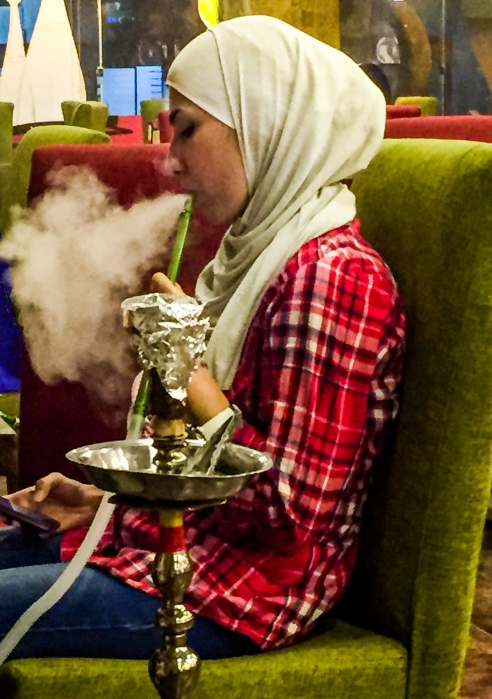
Next post: The Roman ruins of Jerash, Kerak Castle, and floating in the Dead Sea.
All words and images by Alison Louise Armstrong unless otherwise noted
© Alison Louise Armstrong and Adventures in Wonderland – a pilgrimage of the heart, 2010-2016.

Appreciating the way you write about your adventures, and all the pictures that you include :). Yes, traveling always reminds us of our vulnerability, as so many things do these days. I’m feeling very grateful for all the things that “go right” while abroad. Love this post, Ka
LikeLiked by 2 people
Thank you so much Ka. I am always so grateful for all that ‘goes right’. Hope you’re having an awesome time in Italy.
Alison ❤
LikeLiked by 1 person
Your photos are beautiful! What kind of camera do you travel with?
LikeLiked by 1 person
Thank you so much Ann. I’m glad you like them. My camera is a Panasonic FZ1000. It has a built-in 25-400mm (F2.8-4) zoom. I use Lightroom and Photoshop for editing.
Alison
LikeLike
What an other-worldly experience. It probably would not have been so odd eating with the restaurant menagerie in sight if the bathroom had been clean! I completely understand your nearly inappropriate level of gratitude for being safely delivered ‘home’. Wonderful story.
LikeLiked by 1 person
Thanks Marsha. Oh that restaurant was a trip. I think the whole animal thing was surreal and fun, but the awful food and the filthy bathroom – just no. Glad we found that other place to eat for the next two nights. It was spotless and the food was yummy. Yeah the vulnerability thing – I’m aware of it all the time, have been from day one of our travels, our lives are so frequently in the hands of others. Gratitude is a powerful thing.
Alison
LikeLike
Undoubtedly an interesting part of the world but I don’t know how comfortable I would feel there, in any sense, Alison. I guess I’m a European at heart. 🙂
LikeLiked by 1 person
I think as far as religion goes I’ve led a sheltered life. All religions are patriarchal, but for me Islam is more obvious in its double standard. Turkey and Jordan were my first time in Muslim countries and I did feel confronted by the way women are treated. Nobody wins. It’s been a lot for me to process and I may write a post about how it was for me. Egypt was freer in many ways. As for the filthy bathroom – it was certainly not typical of Jordan and not worse than we’ve encountered elsewhere (e.g. India), and people were generally very welcoming and friendly.
Alison
LikeLiked by 1 person
A fascinating tour, Don and Alison. And I know what you mean about vulnerability. I felt the same when a taxi driver drove me and my friend from Jerusalem to Galilee – a trip of about 100 miles at top speed. I prayed the whole way!! Only afterwards did I realise that he could have dropped us off anywhere in the Judaean desert and no-one would have been any the wiser!! Best wishes to you both for continued safe travel.
LikeLiked by 1 person
Thanks Isabella Rose. Amman did seem a bit provincial after a week in Istanbul, which I think is one of the world’s great cities, but we still found plenty that was interesting. I always love discovering new places. I think I’d have felt the same as you in a speeding taxi in uninhabited lands for 100 miles. Yeah – praying all the way!
Alison
LikeLiked by 1 person
Incredible experience Alison and interestingly documented and photographed~
LikeLiked by 1 person
Thanks Cindy ❤
Alison
LikeLike
Fascinating as always, Alison and Don. You certainly capture the atmosphere in your beautiful photography.
LikeLiked by 1 person
Thanks Ros, I’m glad you enjoyed it. We didn’t know what to expect from Amman, but still found plenty that was fascinating.
Alison
LikeLike
This is such a good post…story! The photos are outstanding, and I especially loved the one of the three men in white walking, and my very favorite is that of Don and the tailor, their smiles are fantastic!
LikeLiked by 1 person
Thanks so much Angeline. The three men in white is one of my faves too. I don’t know what their outfit signifies – we didn’t see others like them. It does seem to be a kind of uniform. And I love the one of Don with the tailor. It really captures how it was with them. We had so much fun, and not a word of Arabic, and them not a word of English. Alison
LikeLiked by 1 person
I was wondering as the chickens and rabbits were wandering around, if the restaurant made a specialty in offering fresh food, if you would have the opportunity to pick out your own rabbit or chicken as they do at live lobster restaurants. BTW, we are now wandering through the Atlantic Provinces of Canada, following my bike route. Yesterday we took a detour into PEI and had a wonderful time in the small, but gorgeous town of Victoria. The mayor saw us out wandering around and came out to personally give us a two hour tour. 🙂 – Curt
LikeLiked by 1 person
Chuckle. There was no mention of fresh food. There was no appearance of fresh food either. And if the chickens we ate came from the menagerie nobody said so, and they probably met their demise long before we arrived, and then were cooked beyond recognition.
I’ve never been to PEI, or to any of Maritime Canada. Pleased to hear the locals are treating you well. 🙂
Alison
LikeLiked by 1 person
Then you have to go… 🙂
LikeLiked by 1 person
Hi Alison & Don,
It was great reading this post, almost like I vicariously took a trip to Amman. Great pictures as well!
Divya
LikeLiked by 1 person
Thank you so much Divya. Amman was pretty interesting. I’ll do another post about Amman later so you can come back for another trip there 🙂
Hope you’re still enjoying Canada. We return home to Vancouver in about 2 weeks.
Alison
LikeLiked by 1 person
Great post Alison and Don. I really loved the photos in this one. I like the 3 guys in traditional clothes talking and the head scarf mannequin heads below them.
I get what you mean about the 2nd class nature of the women’s section. Separate I can understand but lower class doesn’t seem right at all.
Pound for Pound, Jordan is one of my favorite countries. In such a small place you have the Dead Sea, Wadi Rum, Petra, the Red Sea and many ancient castles few people have heard of. And as you say, some of the nicest people you’ll meet.
I look forward to reading more of these and hopefully the food gets better!
LikeLiked by 1 person
Thanks Jeff. I loved the head scarf shop – it’s something you’d not see outside of Muslim countries. Some of those heads were a bit scary though.
Turkey and Jordan were my first Muslim countries – I felt confronted by the double standard. I’ll probably write about it eventually. Nobody wins 😦
Jordan was pretty fabulous, especially Petra and Wadi Rum, but I wasn’t thrilled with all aspects of our tour – I’ll write about it in the coming posts.
The food got better! Even the next night in the hookah bar it was better.
Alison
LikeLike
What a nice ramble around Amman you gave us! I love the look of the sun-baked stone, and now I understand why there is such uniformity. I always wonder how anyone – tourist or native – finds anything in those snarls of merchandise? Necklaces mixed with plates, pipes tangled up with bracelets, and chalices next to … hippos! Picturesque and laugh-worthy at the same time. Your people photos are awesome; I love the 3 white-robed guys and the tailors (and Don, of course!) and many more.
LikeLiked by 1 person
Thanks Lex. I must admit I was not charmed by the appearance of Amman from a distance – I don’t find the sameness of the buildings appealing. That one stand of bric-a-brac/old stuff is fascinating, but yes, how do you ever find anything? Still it was my favourite – I suppose I love the patina of age rather than brassy newness.
Alison
LikeLiked by 1 person
I read this post with great interest as I have never been to Jordan although Zi have been to Israel. I do hope you are going to Petra so that I can read your impressions of it and enjoy your photos!
I know that feeling of vulnerability and dependence and reliance on strangers for their kindness, very well. It takes a high degree of trust to be able to travel to less well frequented by tourist places, and integrate with locals within different cultures. But it is the best of travel as I think it makes us all realize that most people around the world no matter how different, are kind and are helpful.
Terrific photographs especially the walk to the citadel pics that are very alluring and the one of the young girl smoking the hookah.
Great post Alison!
Peta
LikeLiked by 1 person
Thanks Peta. Yes we most definitely went to Petra, had two days there so there will be a post about it. It was THE highlight of Jordan. I think everyone should travel if only to learn how alike we all are and that almost all people almost all of the time are good, and kind, and helpful, and just want a peaceful ordinary life in which to raise their children.
Alison
LikeLike
My husband and I got married in Ajlun, a town not far from Jerash. In the late 1970s and early 1980s, we lived in Damascus, Beirut and Amman. All three were quite different and very enjoyable, with Damascus being my favourite. The tragedy of Syria today breaks my heart.
In these days, Syria and Iraq are not safe places to visit, but overall the Middle East is safe for tourists, and you should expect to be treated with respect and fairness. That said, they’d love you to spend up big on souvenirs.
You mentioned animals in the first restaurant. When we lived in Beirut we ate out often. The food was cheap and delicious. Usually we’d go out for an early evening stroll with a baby in a basket and a dog on a lead. Never once were we refused entry to a restaurant, no matter how posh. This was in the days of the Lebanese civil war and not many dogs survived ‘target practice’, so a pure-bred Belgian shepherd received lots of attention from restaurant staff and other diners. She often got a bowl of water and a small dish of rice and meat before we got our order taken. 🙂
As for the double standards. Yes, there are double standards but that has less to do with Islam than with the Arab male mentality. The double standard is more obvious to tourists, especially in places such as mosques. It is much less common in, say, Indonesia, which has the largest Muslim population in the world.
And on a final note, our second daughter is named Petra.
LikeLiked by 1 person
What an amazing time that must have been for you. It breaks my heart also, the pain and suffering and madness in Syria. I would have loved to have seen Damascus but it’s not meant to be. We deliberately didn’t go to the east of Turkey – too close to the troubled areas. I’d love to go to Jerusalem and we probably will one day.
That dog you had sounds pretty special.
I guess the Arab male mentality is just more pronounced that male mentality throughout the world. I’m only kind of joking. We both know that pretty much all societies are patriarchal and that, to a greater or lesser extent, women fight for equality everywhere except perhaps in some Scandinavian countries. It’s just that it seemed so in my face in Turkey and Jordan.
I very much look forward to visiting Indonesia one day.
I love your daughter’s name!
Alison
LikeLike
Wow another great post with beautiful photos and jam backed with stories within in stories and lost of useful information. I don’t know how the two of you do it both the blog and the travelling.
LikeLiked by 1 person
Thanks so much Louise. Amman was not one of the most exciting cities we’ve visited, but it was still pretty intriguing.
I get sooooo behind with the blog. Here it is May and I’m writing about last October. I’m hoping to catch up over the next five months as we’ll be spending that back in Vancouver.
Alison
LikeLiked by 1 person
I enjoyed this post Alison, and loved the photos. Isn’t it interesting the number of people agreeing about the feelings of vulnerability whilst traveling.
As I was reading your description of that I was reminded of our many travels, especially in China, where Dave and I would discuss our lives being in the hands of strangers.
Sue
LikeLiked by 1 person
Thanks Sue. I think this vulnerability is one of the gifts of travel. You learn to let go or go crazy with worry. After a while worrying all the time gets to be exhausting. And boring. Even after all this time travelling we are still aware of our vulnerability, but way better than we used to be at letting go. Did you travel alone in China or with a tour? We want to go but have heard it’s really difficult to travel there, principally because of language difficulties, so we were thinking of doing a tour.
Alison
LikeLike
Hi Alison.
We took Dave’s 84 year old dad with us to China so we decided to book a Grand China tour with Intrepid Travel. It really was the best decision and I’d highly recommend it, I can’t imagine how we’d have navigated our way around otherwise. We had 11 in our group ranging in ages 24 to 84, we all got along famously, and we remain friends with some of the group.
In fact that’s how I started my blog by writing about that China trip to share with family & friends: http://www.whereverarewe.wordpress.com/category/china
Sue.
LikeLiked by 1 person
I’m guessing you don’t travel with a Smartphone, with its maps feature (among others). As always, a beautiful account with complementary images. Most enjoyable.
LikeLiked by 1 person
Thanks Anne, glad you enjoyed it. Yes we travel with a smart phone (iPhone 6 I think), and have various map apps. Don can’t remember why it wasn’t working in Amman, or if we simply forgot to use it which is entirely possible 🙂
Alison
LikeLike
Alison, your post is a great, comprehensive look at Amman, and would be a huge help for new visitors. We enjoyed our time in Amman, and are happy we visited. But for us, it was a reminder that, no matter how much you plan, things don’t always go according to plan. We read some misleading hotel info, and our hotel experience bordered on a disaster. It was right in the heart of things, which normally wouldn’t be too much of an issue, but the street noise was a constant disturbance. And as you can probably relate, we could’ve moved, but we’d been on the road for a while, so we just couldn’t muster the energy – so we just powered through. But this isn’t just a whinge comment. We really did enjoy Amman. We had some wonderful food and because we were so central it was super easy to see everything. ~James
LikeLiked by 1 person
Thanks so much James. Wow, that sounds like a pretty horrible experience, but I do know that weariness when you’d rather just deal than move. We also had some nice meals there, and then that one experience of appalling food in the menagerie. It isn’t high on our list of best cities, but it still had plenty to offer. I’ll do another post on it later – the Citadel and the Roman Theatre, and more of the souq.
Alison
LikeLike
I really enjoyed this post, Alison and Don. That photo of the three men in white attire is also one of my favorites. I think the costume is called thawb, a traditional men attire in the Gulf states, so I’m guessing they’re from one of those rich GCC countries. I was surprised that in general you felt the women in Jordan were treated as a second class citizen, given the progressive image of Queen Rania. I heard that women in other Muslim-majority countries like Kosovo and Albania are treated more equally with their men counterparts though. And Indonesia, the world’s largest Muslim-majority country, is a place where the ratio of female executives to their male counterparts is one of the highest in Asia, and you can find women doing all kind of jobs, from engineers working at offshore rigs to bus drivers. Before the colonialism era, Indonesia had the first female admiral in the East (16th century) and four successive sultanas (female sultans) in the 17th century. All were Muslims. The current mayor of Surabaya, Indonesia’s second biggest city, is also a Muslim woman.
Unfortunately what happens in the Middle East often shapes people’s perception about Islam. That and the perverted interpretation of the religion by some Muslims only make things worse.
LikeLiked by 1 person
Thanks Bama. I also like the photo of the three men in white. Thanks for the information about their attire. They seem wealthy. They have fancy cufflinks, and their robes are so spotless.
I didn’t at all in general feel that the women in Jordan are treated as second-class citizens. I hardly know how it is for them, but your mention of Queen Rania, who I’d forgotten about, gives me a better context. And makes me realize that in ten days in Jordan, seven of them with a local guide who gave us a great deal of information about the country, not once did we hear mention of Queen Rania. I must go do a search and see what the latest news is of her. My comment was simply about the space allocated for them in the mosques, which always seemed ‘second-class’. I think the Blue Mosque in Istanbul is probably the example that most shouts out at me. That exquisite glorious space, enough to make anyone feel closer to spirit, and women are not allowed in there. I’m happy to hear women are treated well, if not completely equally, in Kosovo and Albania. And of course in Indonesia. I agree with, and am saddened by, your final paragraph. I admit I have limited knowledge. And Turkey and Jordan were the first time I’ve been in Muslim countries. I felt a little confronted by it. And by our tour guide telling us of a woman who was assaulted and the man was found not guilty because she’d been out without a male escort. He clearly agreed with the decision.
Alison
LikeLiked by 1 person
The funny thing is a few days ago I saw a photo of Muslim pilgrims around Kaaba in Mecca, and what struck me most was the fact that men and women walk side by side. Race, school of faith, and gender seem irrelevant, because everyone is equal. Sadly there are many aspects practiced by some Muslims today come from medieval customs instead of Islamic values.
Speaking of the queen, I do wonder how much of an impact she gives to her people. She seems to be very progressive and could become a very good role model for the women in Jordan.
LikeLiked by 1 person
That is wonderful for me to hear about the pilgrims in Mecca, all walking side by side. I think all religions have the capacity to be all inclusive and uplifting, and I love to hear accounts that verify that. I had a quick look at Queen Rania’s own website. She seems to be a very active leader/role model in Jordanian society, and an advocate for women’s rights. I will look into it more and perhaps write something about her in future posts.
Alison
LikeLiked by 1 person
The last picture of mysterious doors and stairways is my favorite this time around, along with the Citadel at sunset. I’ve been to a couple of castles at sunset, and there’s always a feeling about them, as if the past is much closer than it is in the bright afternoon sunlight.
LikeLiked by 1 person
Thanks Felicity. My favourite is the one above with the blue door. I almost didn’t include your favourite, which just goes to show I should not second-guess myself! It had to be included for you. I do so agree about castles and ruins being somehow more appealing, more real and at the same time more mysterious, at sunset. In the half light the past seems to call in a way that it can’t during the day.
Alison
LikeLike
Another interesting post, and no raw meat anywhere.
LikeLiked by 1 person
Chuckle. We both had a laugh over your comment. Glad you enjoyed the post, and the lack of raw meat 🙂
Alison
LikeLike
Wow, thanks for your honest account of your encounter with Amman. I always love how you take the good with the bad, sift through it and end up with the world in your hands. You are so exactly right about putting your fate in the hands of the people you meet while traveling — we all have experiences with this, and for the most part our stories have good endings, helping us maintain our faith in humanity. Your sunset photo near the Citadel is breathtaking. Happy to know you made it that far and experienced the real Jordan along the way.
LikeLiked by 1 person
Thanks so much Kelly. Even though we’re tourists mostly, and just passing through, we’re always looking for an authentic experience of the culture, and local markets are frequently the best place for that. In the souq and in front of the mosque we got a glimpse of the real Amman.
Touch wood the worst that’s happened is that we’ve been ripped off a couple of times by taxi drivers. Oh and a horse and buggy driver in Luxor – that story to come. But yes, like most travellers we’ve learned from experience that almost all people almost all of the time are helpful and kind and friendly. It’s a wonderful feeling.
Alison
LikeLiked by 1 person
Very glad the serendipity mojo is working again. It seems to make all the difference. I could tell it was working immediately when I saw Don and the tailor laughing like old friends about the first joke ever told– the one on which the whole world is based. That is what I got out of that lovely picture. They were laughing and smiling exquisitely about everything.
I was wondering what the plan was for getting back to the hotel after arriving at the citadel for sunset, but of course it worked out perfectly. There are many smiling faces in this post. Many genuine faces. Though I must say eating in a menagerie sounds like quite an experience. I took math classes for several years in row in a building just outside of an eagle cage, the women’s dormitory, a very large football stadium, and a fire and brimstone preacher who launched into our collegiate souls with holy vitriol whenever we passed by. So I can relate.
Peace
Michael
LikeLiked by 1 person
You know I think they really were laughing about the first joke ever told. It certainly wasn’t a joke conventionally told. I remember the first time I got the joke, I mean THE joke. I laughed for days.
There was no plan, except some vague idea that we’d find a cab. And we did. Mojo 🙂
Your menagerie sounds like quite something, especially the preacher. Did you ever answer back? I would have, but then it’s unlikely I’d ever have been in such a place.
Alison
LikeLiked by 1 person
The contrast of the exotic belly dancing costumes, the flowing white robes of the three men and the mannequins wearing the hijabs is very thought provoking. I’ve always found it astounding that so many religions (fundamentalist Christians included!) place an extraordinary emphasis on sex and the approved roles of men and women rather than on love, acceptance and compassion … I love your phrase “serendipity mojo” which seems to cover all those unexpected magic moments in travel as well as those times when you arrive (in spite of everything that could go wrong) exactly where you’d hoped! Anita
LikeLike
I too have been thinking about the overt sexuality of the belly dancing outfits and the contrasting need for women to cover themselves, though I do suspect the belly dancing outfits are more for tourists. I agree it’s astounding, and sad, that almost all religions have a thing about sex, and seem to emphasize it (by denigrating and subjugating it) more than love and compassion. It’s heartbreaking. I think all religions at their core have teachings of love, acceptance and compassion, but they’ve all become distorted over the centuries and seem to be an excuse for “traditions” and rules that arise more from fear than love.
We’ve generally had good “serendipity mojo” so far – knocking on wood. I take nothing for granted! And am grateful every time things go according to plan.
Alison
LikeLike
Another memorable chapter of your adventures in wonderland. I would freak out a bit with no map to follow, but sometimes not knowing where you will end up can produce interesting surprises and in your case this time a welcome cuppa. Were you the only customers in the menagerie restaurant?
LikeLiked by 1 person
Thanks pommepal. We don’t worry too much if we don’t have a map. Sometimes we like to deliberately get lost. It’s a great way to discover things. On the other hand, Don *loves* maps, and usually feel bereft without one. I call him mapmaaaaaan!
There were other customers in the restaurant, but not many. And we didn’t get sick – which felt like a bonus.
Alison
LikeLike
Pleased to hear you stayed well. I like maps, but must admit I find them notoriously hard to decipher.
LikeLiked by 1 person
yes your reflections are wonderful and thoughtful and always make we want to fly away….another beautiful post Alison and Don ❤️
LikeLiked by 1 person
Thanks Hedy for your sweet words. Are you still in Portugal? You could fly from there to . . . . . . . . . . . . . anywhere! Jordan is worth visiting. But then I think just about everywhere is worth visiting.
Have a wonderful day,
Alison
LikeLiked by 1 person
No now back in etown 🙄 I need to move where one can fly and walk more economically 😀 I just walked the river edge also beautiful but not the same…smiles!
LikeLiked by 1 person
Wow. I was hanging on every word. I followed your trip right into the taxi where you talked about vulnerability and your gratitude at the Taxi driver getting you back safely. I think that was a very insightful thought. You know, not knowing if the person you meet in this strange but exciting place will be human and do the right thing. Following your blog!
LikeLiked by 1 person
Thank you! What a wonderful compliment. Always when travelling we’re relying on strangers to do the right thing. I think it may be part of the reason many people don’t travel. And yet we’ve found out how good people are, and kind and helpful. Every now and then, like that taxi ride in Amman, it comes to me how vulnerable we are, and how we have to just trust. It’s a good metaphor for life. Thanks for following.
Alison
LikeLiked by 1 person
Hii Alison and Don,
Hope you liked Amman, beautiful post you have written here, with amazing pictures. I am actually from Amman born and was raised most of my life there.
I wanted to answer you on your question above why mosques design smaller spaces for women.Let me explain first that it’s totally fine in Islam for men and women to pray together in one area as in holy mosque in Mecca where Muslims from all over the world gather and conduct their prayers and rituals. But yet again because Muslim women are not obliged to pray at the mosque, they design smaller space for them.Therefore, architects prefer to provide more space for men since on Friday’s the crowd of men praying reaches to the streets.
Your photos are truly lovely. Although I have been in the downtown area only a couple of times in my life,but it’s one of the unique experiences in Jordan that I love. And it is nice to see a blog about Amman from a tourist.
Thank you for sharing your experience.
LikeLiked by 1 person
Thank you so much. Amman was a great experience – despite that meal 🙂
I will write another post about Amman in a few weeks – we returned and explored the Citadel and other places that I didn’t cover in this post.
Thank you for explaining about the mosques. I do remember reading that many women pray at home so that more space is needed for men, but of course it begs the question why can’t they pray in the same space like they do in Mecca? I think the most glaring example for me (that I have seen) is the Blue Mosque in Istanbul – It is the most glorious space, a space so soaring and beautiful that even the most hardened would surely feel closer to God in such a place. And yet women are not allowed in there. I think everyone loses.
Alison
LikeLike
Excited to read your next post !
I agree with you that the Blue Mosque is one of the most glorious spaces for a spiritual place. I have been there and prayed as well, such a beautiful mosque.
So as I said Islam doesn’t forbid women from entering mosques or praying along with men shoulder to shoulder. But over the years, it became the norm to separate them. So no mingling would be between men and women, and just to focus on worshiping God in the mosque.
LikeLiked by 1 person
I am behind n my blog reading but so glad I got to this one. I felt as if I was walking the streets of Aman with you two. The universe does look out for you and because you are open to it, you meet the most amazing people and have incredible experiences.
LikeLiked by 1 person
Thanks Darlene, that’s the best compliment. Yes, I suppose we are open to it. We do try to focus on the positive, and gratitude, and I know that really helps.
Alison
LikeLike
You are my heroes!!
LikeLiked by 1 person